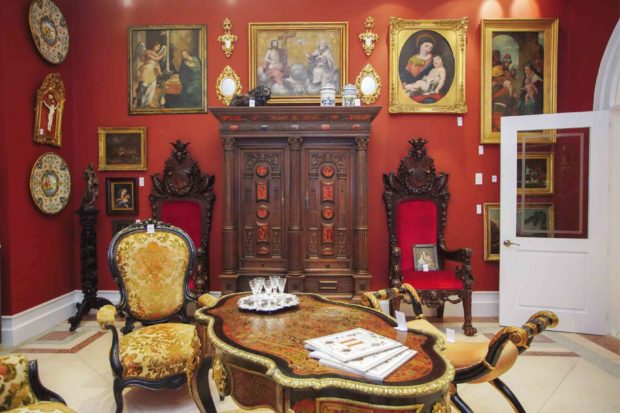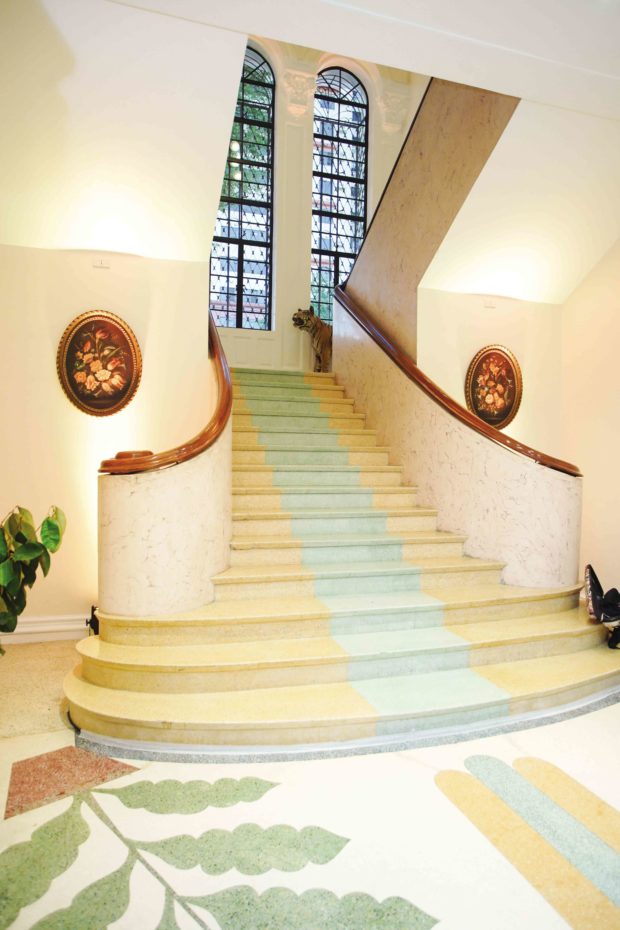
While old houses in Manila are being demolished to give way to condominiums or malls, Philippine Ambassador to Spain Philippe Lhuillier and his family are conserving a prewar mansion.
The former Villaroman Mansion along Bayview Drive in Parañaque has been repurposed into an auction house and events space called Palacio de Memoria.
Casa de Memoria auction house hosted a dinner for 50 people last week in the mansion.
This was how the mansion was reintroduced to the metro, and social media posts of its photos drew people’s curiosity. It became a veritable talk of the town.
The envoy has a keen eye for beauty and antiques, such that he even has a private collection of European antiques in his residence in the south.
Fifteen years ago, he bought this seven-story house said to have belonged to the Villaroman family after the war.
“As their family grew bigger with grandchildren, floors were added, including an elevator,” says Lhuillier’s daughter, Camille, marketing manager of the Palacio and Casa de Memoria auction house in Makati.

She adds that its original owners have remained a mystery. Today’s owners don’t have the original floor plans.
Camille, her sister Angelique Lhuillier-Miranda and cousin Tiffany Mathay, originally wanted the mansion to house the Casa de Memoria auction house, specializing in antique decorative arts. However, the conservation took longer, so they decided instead to set up Casa on Jupiter Street in Makati.
The mansion stands beside the former polo ground in Los Tamaraos Village, in Tambo, Parañaque.
Its façade typifies the Spanish Revival style popular in the American Southeast before World War II.
It has an imperious-looking front entrance with three arched openings, relief ornamentation, wrought-iron grills that frame the upper windows and cantilevered balconies that cover the porches.
Camille says the interiors bear Filipino Art Deco elements, from the window treatments to the local motifs on the flooring.
Grand scale
Casa de Memoria’s art adviser and creative consultant Miguel Rosales recreated the scale, period and character of the first two floors. He drew inspiration from American prewar architect Addison Mizner, who was famous for his Old World-style mansions in Florida.
Mizner’s philosophy was to design a building that looked traditional, drawing on elements from various periods and European styles, yet blending with the environment. He infused his homes with antiquity, while showing off the owner’s affluence.
Rosales’ design approach reflects the European character of the façade, emphasizing the beauty of the flooring, the rich details and varieties of textures. Typical of Mediterranean interiors, dark and dramatic furniture contrasts with the arches and gilded pieces.
Camille says that majority of the furniture are consignments or for sale.
Rosales is also influenced by the opulence of Italian homes, yet he left a lot of empty spaces to let the eyes rest and allow the furniture and architectural details to stand out. The details are plaster or escayola columns, detailed pilasters, gables, decorative cornices and moldings.
In the grand foyer, he maintained the terrazzo flooring, an expensive composite of marble, granite, quartz and glass. Its rarity today increases the value of a property.
The floor pattern is Filipiniana, depicting pink-skinned dancers in costumes of cornflower blue and yellow, grayish brown thatched huts, ochre haystacks and dark green palm trees.
These shades are subtly echoed in the rest of the mansion.
“I colored the background in the palest yellow to bring out moldings in the foyer,” he says.
The original ceiling has a textured paint finish of pink and white, typical of the Spanish Revival style, with medallions or round bas reliefs. The colors had faded over time, lending a feel of history.
The cavernous foyer—the size of a hotel ballroom— called for large-scale pieces. The six-ft-tall Murano chandelier with crystal-blown glass roses nicely ties in the heavy and bold furniture, most of which were turn of-the-19th-century Portuguese, and the Filipino floor patterns.
Rosales’ style adds subtle layers of details in the rooms. For instance, antique blackamoors, sculptures of dark-skinned men, add exoticism to the eclectic look.
Favorite space
Unlike the bold lobby, the adjacent gray room has a softer look, with smaller-scale Napoleon III furniture. Rosales says that an odd corner room —a later addition to the house—has been transformed into a boudoir, decked with a secretaire, a marble-top commode, smaller paintings, gilded wooden furniture, frames and Napoleon III bird-theme porcelain, and glammed up with a crystal Murano chandelier.
Rosales’ favorite room on the ground floor is a cozy space with an unexpected touch of maroon. The ambience was inspired by the romantic and exquisite rooms in Rome and Florence.
The feel of luxury comes with the Renaissance Revival furniture, a Baroque grand mirror, religious paintings, 19th century Victorian furniture, Portuguese chairs with stamped leather upholstery and gilded mirrors, Boulle furniture (known for tortoise shells and marquetry), and brass-and-gilt ormolu.
“My work is about how pieces converse with each other,” he says.
Intimate meals can be had in the dining room, embellished with English Neoclassic details and subtle French details. The 10-seat table has floral marquetry inlay. One of the conversation pieces is a gilded ormolu encrusted with multi-colored stones.
The grand curved staircase is laden with scagliola (imitation marble) and terrazzo. Two-story windows are bordered with precast classical motifs.
Religious paintings and 18th and 19th century tapestries continue the feeling of elegance and luxury.
Table for 50
Walls were knocked down on the upper floors to give way to open floor plans. The second story maintains the Art Deco solid narra and woven patterns in the flooring.
Its far end is a large room with terrazzo flooring, where the dinner for Casa de Memoria’s top clients was held.
To emphasize the grand scale of the room, a long table stretched far enough to accommodate the 50 guests.
A gentleman’s game room has a homey feel, with comfortable furniture and masculine elements such as the taxidermy heads, Art Deco statuettes, overstuffed library chairs and Portuguese furniture in dark woods.
“I wanted to create the feeling of a home instead of a mere events space,” Rosales says.
An open space is temporarily transformed into a gallery of portraits from the 17th to 19th centuries. An interesting detail is a portrait of a Cardinal whose gilt wooden frame bears his crest.
In one vignette, Rosales ties in a picture frame with Greek fret border with a Napolen III commode, embellished with the same pattern. “They weren’t created to match, but I wanted to show the continuity of design between the frame and the commode. I want visitors to learn more about design history and European antiques,” he says.
The creative consultant says Palacio de Memoria is a work in progress.
Camille adds that there are plans to have a museum and a restaurant-bar in the upper floors. “We want to make this an arts destination,” she says.
Palacio de Memoria will be open to the public in March 2019 as it starts its auction season. It will also host lectures on art restoration, how to take care of furniture in the humid climate and art history.
Rosales is also tasked to beautify the grounds. The old pergola will be restored, and the swimming pool transformed into a reflecting pond. He envisions local vines and white flowers cascading from the pergola, and will fill the garden with Japanese lanterns, urns and lush planting.
“It can be used as another venue. The house will be the backdrop. When there is a full moon, I want to see the garden glowing,” he says.
Rosales gives credit to the Lhuilliers for restoring and not replacing elements of the house. “This family wants to save the house, give it a new lease and show how Manila was like in the past,” he says. –CONTRIBUTED
Palacio de Memoria is at 95 Bayview Drive, Los Tamaraos Village, Barangay Tambo, Parañaque. Open by appointment only; call Casa de Memoria at 7599804.

